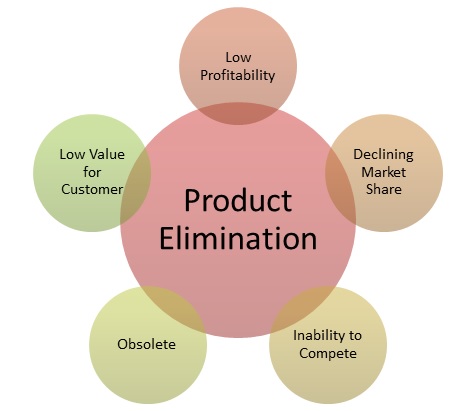Product Elimination - Definition, Importance, Factors & Example
What is Product Elimination?
Product elimination is the decision to drop a product from the portfolio based on its poor market performance. The market demand for such products has been dipped to none and hence product elimination or closure is carried out. Product elimination can also mean that only product under an umbrella brand needs to be stopped and not the entire portfolio.
Importance of Product Elimination
A product life cycle has essentially 4 stages- Development, Growth, Mature and Decline. In the development stage, the product looks to find a place in the market, acquire new customers and produce brand awareness. In the growth phase, the product marks a substantial growth in demand, builds a solid customer base and generates healthy revenue for the company. In the mature phase, the market is nearly saturated and the demand for the product sees no more growth. Revenue collection may start to tumble. In the decline phase, the product loses market share and demand and is making losses. It is in this phase that the Product elimination or product deletion is done.
Each product in the company’s portfolio plays a unique role in the success of the company. When a product stops doing so, it must be dropped by product elimination. They simply drain company’s finances and resources which could be used as investment elsewhere or in developing new products.
Marketers must know when the product enters the decline phase and immediately look to disinvest in the product. The product life cycle can only be extended through innovation. This may help the product stay longer in the growth phase before it matures.

Factors for Product Elimination
Some of the key indicators of declination are-
1. Low Profitability
2. Declining market share
3. Inability to compete
4. Poor fit with the company’s objectives
Marketers may look for several options during product elimination Harvest, Divest or Line simplification.
We can relate product elimination concept to the BCG matrix. A product might find itself in any of the four quadrants. The activity recommendations vary depending on the quadrant in which the company’s product lies. A product which is a star or cash cow or question mark should be invested or harvested or divested upon respectively. Under these cases, product elimination is not required. But if a product is in the dog state, it means that the market growth of the product is low and the market share for the specific company is also low. Such products should be eliminated as the product is doing poorly and also the market prospects are grim. The product is draining resources and capital. It may well find itself obsolete with no demand at all and hence, must be eliminated beforehand.
Example of Product Elimination
Apple dropped its once upon a time market leading product- the ipod because with the advent of smartphones, the market demand for ipod declined suddenly. Because Apple ipod was doing well with high market share, ipod found itself in the harvest phase. But as demand declined further and so was the share of Apple, it moved into the dog phase and was subsequently eliminated. This is an example of product elimination.
Hence, this concludes the definition of Product Elimination along with its overview.
This article has been researched & authored by the Business Concepts Team. It has been reviewed & published by the MBA Skool Team. The content on MBA Skool has been created for educational & academic purpose only.
Browse the definition and meaning of more similar terms. The Management Dictionary covers over 1800 business concepts from 5 categories.
Continue Reading:
What is MBA Skool?About Us
MBA Skool is a Knowledge Resource for Management Students, Aspirants & Professionals.
Business Courses
Quizzes & Skills
Quizzes test your expertise in business and Skill tests evaluate your management traits
Related Content
All Business Sections
Write for Us